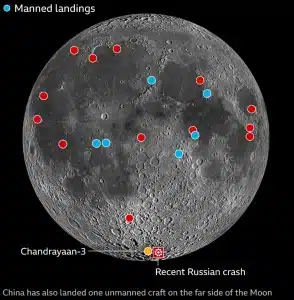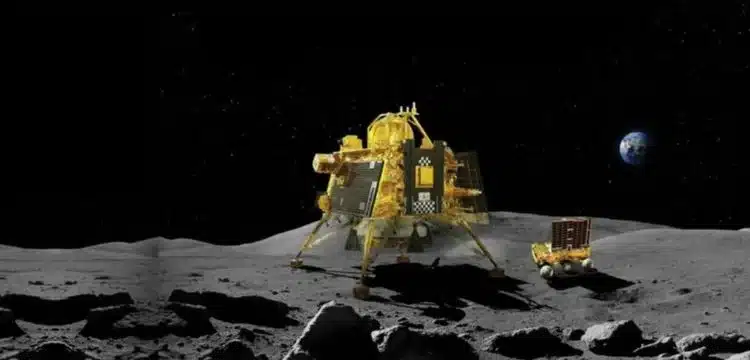[vc_row][vc_column][vc_column_text dp_text_size=”size-4″]India’s Moon mission has created history by being the first to land in the lunar south pole region.
With this achievement, India joins an elite group of countries that have achieved a soft landing on the Moon, including the United States, the former Soviet Union, and China.
At 18:04 local time (12:34 GMT), the Vikram lander from Chandrayaan-3 successfully touched down.

Celebrations erupted across the country, with Prime Minister Narendra Modi declaring that “India is now on the Moon.”
“We have gone where no other country has gone before.” “It’s a happy occasion,” he added. Mr. Modi was watching the event in real time from South Africa, where he is attending the Brics conference.
Also Read: Record Electricity Generation in Pakistan’s History
The successful landing, according to Indian Space Research Organisation (Isro) chief Sreedhara Panicker Somanath, “is not our work alone; this is the work of a generation of Isro scientists.”
India’s accomplishment comes just days after Russia’s Luna-25 spacecraft lost control and collided with the Moon.
The collision also highlighted how difficult it is to land in the south pole region, where the surface is “very uneven” and “filled with craters and boulders.”
India’s second lunar mission, which intended to soft-land there in 2019, was likewise a failure, with the lander and rover destroyed but the orbiter surviving.
On Wednesday, the lander, dubbed Vikram after Isro founder Vikram Sarabhai, began its perilous fall, carrying within its belly the 26kg rover named Pragyaan (the Sanskrit word for wisdom).
The lander’s speed was progressively reduced from 1.68km/s to nearly nothing, allowing it to land softly on the lunar surface.
After the dust settles, the six-wheeled rover will crawl out of the lander’s belly and travel around the Moon’s rocks and craters, gathering critical data and photographs for transmission to Earth.
What is the next step in India’s Moon mission?
One of the mission’s primary objectives is to search for water-based ice, which experts believe could one day enable human habitation on the Moon. It might potentially be used to provide propellant to spacecraft travelling to Mars and other distant locations. According to scientists, the surface area that remains in permanent shadow there is vast and could retain water ice supplies.
The lander and rover are equipped with five scientific equipment that will aid in the discovery of the physical properties of the Moon’s surface, the atmosphere close to the surface, and tectonic activity to research what happens beneath the surface.
An official informed the BBC that the rover is carrying an Indian flag and that its wheels have Isro’s trademark and insignia imprinted on them so that they leave imprints on the lunar dirt during the Moon trek.
 [/vc_column_text][/vc_column][/vc_row]
[/vc_column_text][/vc_column][/vc_row]











